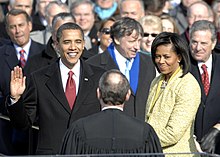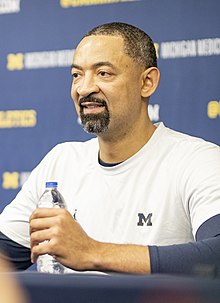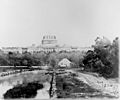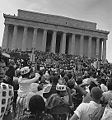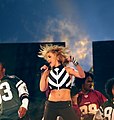Portal:Washington, D.C.
Portal maintenance status: (No date set)
|
The Washington, D.C. portal

Washington, D.C., formally the District of Columbia and commonly known as Washington or D.C., is the capital city and federal district of the United States. The city is on the Potomac River, across from Virginia, and shares land borders with Maryland to its north and east. It was named after George Washington, the first president of the United States. The district is named after Columbia, the female personification of the nation.
The U.S. Constitution in 1789 called for the creation of a federal district under the exclusive jurisdiction of the U.S. Congress. As such, Washington, D.C., is not part of any state, and is not one itself. The Residence Act, adopted on July 16, 1790, approved the creation of the capital district along the Potomac River. The city was founded in 1791, and the 6th Congress held the first session in the unfinished Capitol Building in 1800 after the capital moved from Philadelphia. In 1801, the District of Columbia, formerly part of Maryland and Virginia and including the existing settlements of Georgetown and Alexandria, was officially recognized as the federal district; initially, the city was a separate settlement within the larger district. In 1846, Congress returned the land originally ceded by Virginia, including the city of Alexandria. In 1871, it created a single municipality for the remaining portion of the district. There have been several unsuccessful efforts to make the district into a state since the 1880s; a statehood bill passed the House of Representatives in 2021 but was not adopted by the U.S. Senate. To become law it would have to be passed by the Senate and signed by president; it would have renamed the city Washington, Douglas Commonwealth and shrunk the Federal District to about the size of the national mall.
Washington, D.C. anchors the southern end of the Northeast megalopolis. As the seat of the U.S. federal government, the city is an important world political capital. The city hosts the buildings that house federal government headquarters, including the White House, the Capitol, the Supreme Court Building, and multiple federal departments and agencies. The city is home to many national monuments and museums, located most prominently on or around the National Mall, including the Jefferson Memorial, the Lincoln Memorial, and the Washington Monument. It hosts 177 foreign embassies and serves as the headquarters for the World Bank, the International Monetary Fund, the Organization of American States, and other international organizations. Home to many of the nation's largest industry associations, non-profit organizations, and think tanks, D.C. is known as a lobbying hub, with K Street as the industry center. The city had 20.7 million domestic visitors and 1.2 million international visitors, ranking seventh among U.S. cities as of 2022. (Full article...)
-
Image 1
The first inauguration of Barack Obama as the 44th president of the United States took place on Tuesday, January 20, 2009, at the West Front of the United States Capitol in Washington, D.C. The 56th inauguration, which set a record attendance for any event held in the city, marked the commencement of the first term of Barack Obama as president and Joe Biden as vice president. Based on combined attendance numbers, television viewership, and Internet traffic, it was one of the most-observed events ever by the global audience at the time. (Full article...) -
Image 2
James Madison (March 16, 1751 – June 28, 1836) was an American statesman, diplomat, and Founding Father who served as the fourth president of the United States from 1809 to 1817. Madison was popularly acclaimed the "Father of the Constitution" for his pivotal role in drafting and promoting the Constitution of the United States and the Bill of Rights. (Full article...) -
Image 3

John William Beschter SJ (born Johann Wilhelm Beschter; German: [ˈjoːhan ˈvɪlhɛlm ˈbɛʃtɐ]; [needs Luxembourgish IPA] May 20, 1763 – January 6, 1842) was a Catholic priest and Jesuit from the Duchy of Luxembourg in the Austrian Netherlands. He emigrated to the United States as a missionary in 1807, where he ministered in rural Pennsylvania and Maryland. Beschter was the last Jesuit pastor of St. Mary's Church in Lancaster, as well as the pastor of St. John the Evangelist Church in Baltimore, Maryland. He was also a priest at several other German-speaking churches in Pennsylvania. (Full article...) -
Image 4
Joseph Havens Richards SJ (born Havens Cowles Richards; November 8, 1851 – June 9, 1923) was an American Catholic priest and Jesuit who became a prominent president of Georgetown University, where he instituted major reforms and significantly enhanced the quality and stature of the university. Richards was born to a prominent Ohio family; his father was an Episcopal priest who controversially converted to Catholicism and had the infant Richards secretly baptized as a Catholic. (Full article...) -
Image 5
John Dunning Whitney SJ (July 19, 1850 – November 27, 1917) was an American Catholic priest and Jesuit who became the president of Georgetown University in 1898. Born in Massachusetts, he joined the United States Navy at the age of 16, where he was introduced to Catholicism by way of a book that accidentally came into his possession and prompted him to become a Catholic. He entered the Society of Jesus and spent the next twenty-five years studying and teaching mathematics at Jesuit institutions around the world, including in Canada, England, Ireland, and around the United States in New York, Maryland, Boston, and Louisiana. He became the vice president of Spring Hill College in Alabama before being appointed the president of Georgetown University. (Full article...) -
Image 6
Patrick Francis Healy SJ (February 27, 1834 – January 10, 1910) was an American Catholic priest and Jesuit who was an influential president of Georgetown University, becoming known as its "second founder". The university's flagship building, Healy Hall, bears his name. Though he considered himself and was widely accepted as White, Healy was posthumously recognized as the first Black American to earn a PhD, as well as the first to enter the Jesuit order and to become the president of a predominantly White university. (Full article...) -
Image 7
James Abram Garfield (November 19, 1831 – September 19, 1881) was the 20th president of the United States, serving from March 1881 until his assassination in September that year. A preacher, lawyer, and Civil War general, Garfield served nine terms in the United States House of Representatives and is the only sitting member of the House to be elected president. Before his candidacy for the presidency, he had been elected to the U.S. Senate by the Ohio General Assembly—a position he declined when he became president-elect. (Full article...) -
Image 8
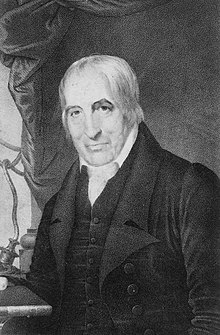
Francis Ignatius Neale SJ (June 3, 1756 – December 20, 1837), also known as Francis Xavier Neale, was an American Catholic priest and Jesuit who led several academic and religious institutions in Washington, D.C., and Maryland. He played a substantial role in the Jesuit order's resurgence in the United States. (Full article...) -
Image 9

Giovanni Antonio Grassi SJ (anglicized as John Anthony Grassi; 10 September 1775 – 12 December 1849) was an Italian Catholic priest and Jesuit who led many academic and religious institutions in Europe and the United States, including Georgetown College in Washington, D.C., and the Pontificio Collegio Urbano de Propaganda Fide in Rome. (Full article...) -
Image 10On June 19, 1838, the Maryland Province of the Society of Jesus agreed to sell 272 slaves to two Louisiana planters, Henry Johnson and Jesse Batey, for $115,000 (equivalent to approximately $3.25 million in 2023). This sale was the culmination of a contentious and long-running debate among the Maryland Jesuits over whether to keep, sell, or free their slaves, and whether to focus on their rural estates or on their growing urban missions, including their schools. (Full article...)
-
Image 11

William McSherry SJ (July 19, 1799 – December 18, 1839) was an American Catholic priest and Jesuit who became the president of Georgetown College and a Jesuit provincial superior. The son of Irish immigrants, McSherry was educated at Georgetown College, where he entered the Society of Jesus. As one of the first Americans to complete the traditional Jesuit course of training, he was sent to Rome to be educated for the priesthood. There, he made several discoveries of significant, forgotten holdings in the Jesuit archives, which improved historians' knowledge of the early European settling of Maryland and of the language of Indian tribes there. (Full article...) -
Image 12
Harmon Clayton Killebrew Jr. (/ˈkɪlɪbruː/; June 29, 1936 – May 17, 2011), nicknamed "the Killer" and "Hammerin' Harmon", was an American professional baseball first baseman, third baseman, and left fielder. He spent most of his 22-year career in Major League Baseball (MLB) with the Minnesota Twins. A prolific power hitter, Killebrew had the fifth-most home runs in major league history at the time of his retirement. He was second only to Babe Ruth in American League (AL) home runs, and was the AL career leader in home runs by a right-handed batter. Killebrew was inducted into the National Baseball Hall of Fame in 1984. (Full article...) -
Image 13

Nativity, c. mid-1450s. Oil on wood, 127.6 cm × 94.9 cm (50.2 in × 37.4 in), National Gallery of Art, Washington, D.C.
The Nativity is a devotional mid-1450s oil-on-wood panel painting by the Early Netherlandish painter Petrus Christus. It shows a nativity scene with grisaille archways and trompe-l'œil sculptured reliefs. Christus was influenced by the first generation of Netherlandish artists, especially Jan van Eyck and Rogier van der Weyden, and the panel is characteristic of the simplicity and naturalism of art of that period. Placing archways as a framing device is a typical van der Weyden device, and here likely borrowed from that artist's Saint John Altarpiece and Miraflores Altarpiece. Yet Christus adapts these painterly motifs to a uniquely mid-15th century sensibility, and the unusually large panel – perhaps painted as a central altarpiece panel for a triptych – is nuanced and visually complex. It shows his usual harmonious composition and employment of one-point-perspective, especially evident in the geometric forms of the shed's roof, and his bold use of color. It is one of Christus's most important works. Max Friedländer definitely attributed the panel to Christus in 1930, concluding that "in scope and importance, [it] is superior to all other known creations of this master." (Full article...) -
Image 14
James Knox Polk (/poʊk/; November 2, 1795 – June 15, 1849) was the 11th president of the United States, serving from 1845 to 1849. A protégé of Andrew Jackson and a member of the Democratic Party, he was an advocate of Jacksonian democracy and extending the territory of the United States. Polk led the U.S. into the Mexican–American War, and after winning the war he annexed the Republic of Texas, the Oregon Territory, and the Mexican Cession. (Full article...) -
Image 15
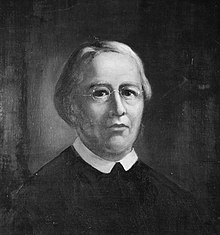
William Feiner SJ (born Wilhelm Feiner; December 27, 1792 – June 9, 1829) was a German Catholic priest and Jesuit who became a missionary to the United States and eventually the president of Georgetown College, now known as Georgetown University. (Full article...) -
Image 16
Michael Jeffrey Jordan (born February 17, 1963), also known by his initials MJ, is an American businessman and former professional basketball player. He played 15 seasons in the National Basketball Association (NBA) between 1984 and 2003, winning six NBA championships with the Chicago Bulls. He was integral in popularizing basketball and the NBA around the world in the 1980s and 1990s, becoming a global cultural icon. His profile on the NBA website states, "By acclamation, Michael Jordan is the greatest basketball player of all time." (Full article...) -
Image 17
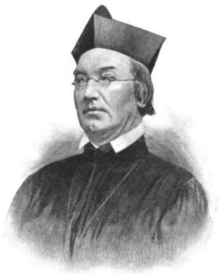
John Early SJ (July 1, 1814 – May 23, 1873) was an Irish-American Catholic priest and Jesuit educator who was the president of the College of the Holy Cross and Georgetown University, as well as the founder and first president of Loyola College in Maryland. Born in Ireland, he emigrated to the United States at the age of nineteen. Upon his arrival, he enrolled at Mount St. Mary's Seminary in Maryland and entered the Society of Jesus, completing his education at Georgetown University in Washington, D.C. (Full article...) -
Image 18
Andrew Jackson (March 15, 1767 – June 8, 1845) was the seventh president of the United States, serving from 1829 to 1837. Before his presidency, he gained fame as a general in the U.S. Army and served in both houses of the U.S. Congress. Often praised as an advocate for ordinary Americans and for his work in preserving the union of states, Jackson has also been criticized for his racial policies, particularly his treatment of Native Americans. (Full article...) -
Image 19Howard as head coach of Michigan in 2020
Juwan Antonio Howard (first name /dʒuː.ˈwɑːn/, born February 7, 1973) is an American professional basketball coach and former player who is an assistant coach for the Brooklyn Nets of the National Basketball Association (NBA). He previously served as the head coach of the Michigan Wolverines men's team from 2019 to 2024 before joining the Nets in 2024. (Full article...) -
Image 20William Matthews (December 16, 1770 – April 30, 1854), occasionally spelled Mathews, was an American who became the fifth Roman Catholic priest ordained in the United States and the first such person born in British America. Born in the colonial Province of Maryland, he was briefly a novice in the Society of Jesus. After being ordained, he became influential in establishing Catholic parochial and educational institutions in Washington, D.C. He was the second pastor of St. Patrick's Church, serving for most of his life. He served as the sixth president of Georgetown College, later known as Georgetown University. Matthews acted as president of the Washington Catholic Seminary, which became Gonzaga College High School, and oversaw the continuity of the school during suppression by the church and financial insecurity. (Full article...)
-
Image 21

Joseph Anton Lopez SJ (born José Antonio López; October 4, 1779 – October 5, 1841) was a Mexican Catholic priest and Jesuit. Born in Michoacán, he studied canon law at the Colegio de San Nicolás and the Royal and Pontifical University of Mexico. He became acquainted with the future Empress consort Ana María Huarte and was made chaplain to the future imperial family. He was later put in charge of the education of all the princes in Mexico. Lopez was a close ally of Emperor Agustín de Iturbide, residing in Madrid for four years as his attorney and political informant, and accompanying him during his exile to Italy and England. (Full article...) -
Image 22Enoch Fenwick SJ (May 15, 1780 – November 25, 1827) was an American Catholic priest and Jesuit who ministered throughout Maryland and became the twelfth president of Georgetown College. Descending from one of the original Catholic settlers of the Province of Maryland, he studied at Georgetown College in what is now Washington, D.C. Like his brother and future bishop, Benedict Joseph Fenwick, he entered the priesthood, studying at St. Mary's Seminary before entering the Society of Jesus, which was suppressed at the time. He was made rector of St. Peter's Pro-Cathedral in Baltimore by Archbishop John Carroll, and remained in the position for ten years. Near the end of his pastorate, he was also made vicar general of the Archdiocese of Baltimore, which involved traveling to say Mass in remote parishes throughout rural Maryland. (Full article...)
-
Image 23

Thomas F. Mulledy SJ (/mʌˈleɪdi/ muh-LAY-dee; August 12, 1794 – July 20, 1860) was an American Catholic priest and Jesuit who became the president of Georgetown College, a founder of the College of the Holy Cross, and a Jesuit provincial superior. His brother, Samuel Mulledy, also became a Jesuit and president of Georgetown. (Full article...) -
Image 24
James Aloysius Doonan SJ (November 8, 1841 – April 12, 1911) was an American Catholic priest and Jesuit, who was the president of Georgetown University from 1882 to 1888. During that time he oversaw the naming of Gaston Hall and the construction of a new building for the School of Medicine. Doonan also acquired two historic cannons that were placed in front of Healy Hall. His presidency was financially successful, with a reduction in the university's burdensome debt that had accrued during the construction of Healy Hall. (Full article...) -
Image 25
On February 17, 1974, U.S. Army Private First Class Robert Kenneth Preston (1953–2009) took off in a stolen Bell UH-1B Iroquois "Huey" helicopter from Tipton Field, Maryland, and landed it on the South Lawn of the White House in a significant breach of security. Preston had enlisted in the Army to become a helicopter pilot. However, he did not graduate from the helicopter training course and lost his opportunity to attain the rank of warrant officer pilot. His enlistment bound him to serve four years in the Army, and he was sent to Fort Meade as a helicopter mechanic. Preston believed this situation was unfair and later said he stole the helicopter to show his skill as a pilot. (Full article...)
Neighboorhoods
-
Image 1
Garfield Heights is a residential neighborhood in Southeast Bounded by Suitland Parkway SE, Alabama Avenue SE, 28th Street SE, Gainesville Street SE, Naylor Road SE, and Southern Avenue SE.Washington, D.C., bordering Prince George's County, Maryland. Garfield Heights contains both apartment units and single-family detached houses. (Full article...) -
Image 2
Woodridge is a residential neighborhood located in Ward 5 of Northeast Washington, D.C. Woodridge is contained between Eastern Avenue N.E. to the east, Taylor Street N.E. to the north, South Dakota Avenue N.E. to the west, and Bladensburg Road N.E. to the south. Its central commercial strips are Rhode Island Avenue NE (Route 1) and Bladensburg Road N.E. Woodridge borders the adjacent neighborhoods of Brookland, Langdon, North Michigan Park, and Fort Lincoln in Northeast Washington D.C. In addition to these neighborhoods in the District of Columbia, Woodridge borders the city of Mount Rainier and town of Cottage City in Maryland. In terms of public transportation, residents of Woodridge have access to the Brookland-CUA and Rhode Island Avenue Metro stations. (Full article...) -
Image 3Lincoln Park looking west from Mary McLeod Bethune Statue
Lincoln Park is the largest urban park located in the Capitol Hill neighborhood of Washington, D.C. It was known historically as Lincoln Square. From 1862 to 1865, it was the site of the largest hospital in Washington, DC: Lincoln Hospital. (Full article...) -
Image 4
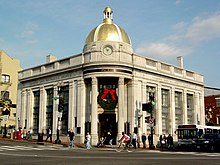
Georgetown is a historic neighborhood and commercial district in Northwest Washington, D.C., situated along the Potomac River. Founded in 1751 as part of the colonial-era Province of Maryland, Georgetown predated the establishment of Washington, D.C. by 40 years. Georgetown was an independent municipality until 1871 when the United States Congress created a new consolidated government for the entire District of Columbia. A separate act, passed in 1895, repealed Georgetown's remaining local ordinances and renamed Georgetown's streets to conform with those in Washington, D.C. (Full article...) -
Image 5
Kenilworth is a residential neighborhood in Northeast Washington, D.C., located on the eastern bank of the Anacostia River and just inside the D.C.-Maryland border. A large public housing complex, Kenilworth Courts, dominates the area. The neighborhood is famous for the Kenilworth Park and Aquatic Gardens, a national park whose centerpiece is a series of ponds carved out of Anacostia River marshland. Visitors come especially during June and July to see the beautiful blooming water lilies and lotus flowers. In 1895 the name “Kenilworth” was first applied to the area by white real estate developer Allen Mallery, who named this neighborhood after Kenilworth Castle in England, the ruins of which can still be seen today in Warwickshire. Kenilworth Park, which includes the Kenilworth-Parkside Recreation Center, also carries the neighborhood name, though most of the park's area is actually located adjacent to the modern neighborhoods of Parkside and Eastland Gardens. (Full article...) -
Image 6
Douglass is a residential neighborhood in Southeast Washington, D.C., on the eastern side of St. Elizabeths Hospital, on the border of the Congress Heights Metro Station. It is bounded by Suitland Parkway SE, Alabama Avenue SE, and Saint Elizabeth's Hospital Campus. (Full article...) -
Image 7

Map of Washington, D.C., with Manor Park highlighted in red
Manor Park is a neighborhood in Ward 4 of northwest Washington, D.C. (Full article...) -
Image 8Map of Washington, D.C., with Kent highlighted in red
Kent is a neighborhood in Northwest Washington, D.C. in the United States, bounded by Loughboro Road to the north, MacArthur Boulevard to the southwest, and Chain Bridge Road and Battery Kemble Park to the southeast. It is a suburban neighborhood, home to some of the most expensive homes in the city with an average home sales price in 2012 of $1.7 million ($2.26 million today). (Full article...) -
Image 9
Selected image
-
Image 1The Library of Congress, the world's largest library with more than 167 million cataloged items and the nation's oldest cultural institution (from Washington, D.C.)
-
Image 2The National Gallery of Art was the most visited art museum in the United States in 2022. (from Washington, D.C.)
-
Image 3US Capitol in the 2010 blizzard (from Washington, D.C.)
-
Image 4Library of Congress(from National Mall)
The "Grand Avenue" or Mall as proposed by Pierre L'Enfant, 1791 -
Image 5President Abraham Lincoln insisted that construction of the United States Capitol continue during the Civil War. (from History of Washington, D.C.)
-
Image 72009 view from the United States Capitol facing west, over the Grant Memorial and Capitol Reflecting Pool in the foreground, and across the National Mall towards the Washington Monument (from National Mall)
-
Image 8John F. Kennedy Center for the Performing Arts (from National Mall)
-
Image 10Axis undergoing restoration (October 2015) (from National Mall)
-
Image 11City of Washington from Beyond the Navy Yard, an 1833 portrait by George Cooke in the Oval Office in the White House (from History of Washington, D.C.)
-
Image 13The Vietnam Veterans Memorial, designed by Maya Lin, was initially controversial for its lack of heroic iconography, a departure from earlier memorial designs. (from Washington, D.C.)
-
Image 151963 March on Washington for Jobs and Freedom on the National Mall facing east from the Lincoln Memorial (from National Mall)
-
Image 16The Chesapeake and Ohio Canal was extended to Georgetown in 1830. (from Washington, D.C.)
-
Image 17The March on Washington at the Lincoln Memorial Reflecting Pool on August 28, 1963 (from Washington, D.C.)
-
Image 19The Pentagon following the September 11 attacks with the Washington Monument visible in the background (from History of Washington, D.C.)
-
Image 22Map of the Mall in 1893 showing the Monument Grounds (with the Washington Monument), Agricultural Grounds (with the Dept. of Agriculture), Smithsonian Grounds (with the Castle and Arts and Industries museum), Armory Square, Public Grounds and Botanical Garden, as well as parts of the recently created "Tidal Reservoir" and "Proposed Park" (from National Mall)
-
Image 23Washington, D.C., police on Harley-Davidson motorcycles escort the March for Life protest on Constitution Avenue in January 2018. (from Washington, D.C.)
-
Image 24Territorial progression of Washington, D.C. (from History of Washington, D.C.)
-
Image 25The Blue Plains Advanced Wastewater Treatment Plant in D.C. is the largest advanced wastewater treatment facility in the world. (from Washington, D.C.)
-
Image 26The city's license plate calls for an end to taxation without representation. (from Washington, D.C.)
-
Image 27With over 30,000 participants, the annual Marine Corps Marathon, held annually in October, is the largest non-prize money marathon in the country. (from Washington, D.C.)
-
Image 28National Mall, a landscaped park extending from the Lincoln Memorial to the United States Capitol (from Washington, D.C.)
-
Image 29The National Mall was the centerpiece of the 1902 McMillan Plan. A central open vista traversed the length of the Mall. (from National Mall)
-
Image 30Memorial Bridge connects the city across the Potomac River with Arlington, Virginia. (from Washington, D.C.)
-
Image 31The United States Capitol in 1846, prior to the addition of the current rotunda (from History of Washington, D.C.)
-
Image 33The southern portion of the National Mall in 1863 during the American Civil War (from History of Washington, D.C.)
-
Image 34The Mall following a snow storm (from National Mall)
-
Image 35The city's African American population has declined since the 1968 riots. (from Washington, D.C.)
-
Image 36The Smithsonian Museum of Natural History was the most visited museum in the U.S. in 2022, with 3.9 million visits. (from Washington, D.C.)
-
Image 38Civil rights marchers during the March on Washington at the Lincoln Memorial on August 28, 1963 (from History of Washington, D.C.)
-
Image 39D.C. is on the north side of the Potomac River, and is surrounded on three side by Maryland. Virginia lies across the river to the south-west (from Washington, D.C.)
-
Image 41Lincoln Memorial Reflecting Pool before reconstruction (April 2010) (from National Mall)
-
Image 42Construction of the Washington Metro on Connecticut Avenue in 1973 (from History of Washington, D.C.)
-
Image 43The Eisenhower Executive Office Building, built between 1871 and 1888, was the world's largest office building until 1943, when it was surpassed by The Pentagon. (from Washington, D.C.)
-
Image 45A panel discussion at the American Enterprise Institute, one of D.C.'s many think tanks (from Washington, D.C.)
-
Image 48The National World War II Memorial is among the many popular tourist sites located on the National Mall. (from Washington, D.C.)
-
Image 49Duke Ellington School of the Arts, a public magnet school in the city (from Washington, D.C.)
-
Image 52An 1814 watercolor illustration of the United States Capitol after the burning of Washington during the War of 1812 (from History of Washington, D.C.)
-
Image 53Pool after reconstruction (May 2016) (from National Mall)
-
Image 54A major bus strike in May 1974 caused huge traffic jams throughout the city (from History of Washington, D.C.)
-
Image 55Georgetown University, founded in 1789, is the city's oldest university. (from Washington, D.C.)
-
Image 56Reading Room at the Library fo Congress (from National Mall)
-
Image 58On September 18, 1783, an engraving of George Washington, known as the First Cornerstone, was placed as the corner stone of the United States Capitol. (from History of Washington, D.C.)
-
Image 61One Franklin Square, located in Downtown, hosts the headquarters of The Washington Post. (from Washington, D.C.)
-
Image 62The Northeast Boundary No. 4 marker stone of the original border between the District of Columbia and Prince George's County, Maryland (from History of Washington, D.C.)
-
Image 63The Washington Monument stood in this unfinished form for 25 years before being completed in 1884. (from History of Washington, D.C.)
-
Image 64National Mall proper and adjacent areas (April 2002). The Mall had a grassy lawn flanked on each side by unpaved paths and rows of American elm trees as its central feature. (Numbers in the image correspond to numbers in the list of landmarks, museums and other features below.) (from National Mall)
-
Image 65The Washington Capitals, an NHL team, and the Washington Wizards, an NBA team, both play at Capital One Arena. (from Washington, D.C.)
-
Image 68Rows of young American elm trees on the National Mall, looking east from the top of the Washington Monument, circa 1942 (from National Mall)
-
Image 69Axis after restoration (September 2016) (from National Mall)
-
Image 71Demonstrators marching down Pennsylvania Avenue towards the United States Capitol on January 6, 2021 (from History of Washington, D.C.)
-
Image 72The Aqueduct Bridge crossing the Potomac River, with Northern Virginia in the background and the Chesapeake and Ohio Canal in the foreground (from History of Washington, D.C.)
-
Image 73The John A. Wilson Building is the headquarters for much of the Government of the District of Columbia, including the offices of the mayor and D.C. Council. (from Washington, D.C.)
-
Image 75Reagan Washington National Airport in Arlington, Virginia is the closest airport to the city among the three major Washington metropolitan area airports. (from Washington, D.C.)
-
Image 76The first inauguration of Barack Obama on January 20, 2009, facing west from the Capitol (from National Mall)
-
Image 77The Jefferson Memorial and many of D.C.'s other monuments are built in the Neoclassical style. (from Washington, D.C.)
-
Image 78Ben's Chili Bowl, known for its half-smoke, a historic staple of the city's cuisine (from Washington, D.C.)
-
Image 79Eisenhower Memorial at night, 2021 (from National Mall)
-
Image 81Metrobus, operated by the Washington Metropolitan Area Transit Authority (from Washington, D.C.)
-
Image 82This view from the top of the Washington Monument shows rows of elm trees lining the Reflecting Pool (November 2014). (from National Mall)
-
Image 83Eastward view of the National Mall from the top of the Washington Monument in 1918. The three structures and two chimneys crossing the Mall are temporary World War I buildings A, B and C and parts of their central power plant. (from National Mall)
-
Image 84Westward view from the top of the Washington Monument in 1943 or 1944 during World War II. In the foreground, temporary buildings on the Washington Monument grounds house the Navy's Bureau of Ships. The Main Navy and Munitions Buildings stand to the right of the Lincoln Memorial Reflecting Pool. Temporary buildings to the left of the Reflecting Pool house the Navy's Bureau of Supplies and Accounts. (from National Mall)
-
Image 85Facing east on the National Mall, as viewed near the 1300 block of Jefferson Drive, S.W. in April 2010. Rows of American elm trees line the sides of a path traversing the length of the Mall. (from National Mall)
-
Image 86The Washington Monument viewed from the Tidal Basin during the National Cherry Blossom Festival in April 2018 (from Washington, D.C.)
-
Image 88The April 9, 1939, concert by Marian Anderson, facing east from the Lincoln Memorial (from National Mall)
-
Image 90The Federal Triangle, a historic hub of executive departments of the U.S. federal government (from Washington, D.C.)
-
Image 92After their victory at the Battle of Bladensburg in 1814, the British Army burned the White House and other buildings during a one-day occupation of Washington, D.C. (from Washington, D.C.)
-
Image 93Britney Spears performs during the "NFL Kickoff Live from the National Mall Presented by Pepsi Vanilla" concert, September 4, 2003 (from National Mall)
-
Image 94General Dwight D. Eisenhower received a hero's welcome in the city in June 1945 following the Allied victory in World War II (from History of Washington, D.C.)
-
Image 95Washington Monument and the White House. Since 1961 the city's residents can vote for the President and Vice President, who is also the President of the Senate (from Washington, D.C.)
-
Image 96West side of the U.S. Capitol building (March 2019) (from National Mall)
-
Image 97The United States Congress began assembling in the new United States Capitol in 1800 after the nation's capital was moved from Philadelphia. (from Washington, D.C.)
-
Image 99The Concert for Valor on the National Mall on November 11, 2014, looking west from the U.S. Capitol grounds (from National Mall)
-
Image 100A performance of Moulin Rouge! at the Kennedy Center for the Performing Arts (from Washington, D.C.)
-
Image 101Yetsom beyaynetu at Das Ethiopian Cuisine, one of D.C.'s many Ethiopian restaurants (from Washington, D.C.)
-
Image 102The National Mall, including a central pathway through it, the centerpiece of the 1901 McMillan Plan (from History of Washington, D.C.)
-
Image 105Map of the District of Columbia in 1835, prior to the retrocession (from History of Washington, D.C.)
-
Image 106Looking east from the top of the Washington Monument towards the Mall and the U.S. Capitol, 2023 (from National Mall)
-
Image 108Due to limited dining options on the Mall, food trucks are often parked next to tourist-dense locations. (from National Mall)
-
Image 109Washington Metro, the second-busiest rapid rail system in the U.S. based on average weekday ridership, is known for its iconic vaulted ceilings (from Washington, D.C.)
-
Image 113Portrait of the Mall and vicinity looking northwest from southeast of the U.S. Capitol, circa 1846–1855, showing stables in the foreground, the Washington City Canal behind them, the Capitol on the right and the Smithsonian "Castle", the Washington Monument and the Potomac River in the distant left. (from National Mall)
-
Image 114The U.S. Capitol dome was under construction during Lincoln's first inauguration on March 4, 1861, five weeks before the start of the American Civil War. (from Washington, D.C.)
-
Image 115Rock Creek Park, the city's largest park, stretches across Northwest. (from Washington, D.C.)
-
Image 116Map of racial distribution in the Washington metropolitan area, according to the 2010 U.S. census; each dot represents 25 people: White, Black, Asian, Hispanic or Other (yellow) (from Washington, D.C.)
Did you know...
- ... that a coconut tree meme drove sales of piña coladas in the Washington, D.C., area?
- ... that new employees of a business headquartered in the Editors Building chose their office decorations from a 7,000-piece collection of historic memorabilia of Washington, D.C.?
- ... that after Michael Jordan was fired by the Washington Wizards, he wanted to move the Capital Classic from the Washington, D.C., area to New York?
- ... that residents reported the first cycling club in Washington, D.C., to the police over concerns that bicycles posed a danger to pedestrians?
- ... that a TV station in Washington, D.C., held on-air monkey races as part of its children's programming?
- ... that a woman hitchhiked from Indiana to Washington, D.C., to protest the sale of the radio station where she worked?
In the news
- 6 November 2024 – 2024 U.S. elections
- U.S. Vice President and Democratic Party candidate Kamala Harris concedes defeat to Donald Trump in a speech at Howard University in Washington, D.C., stating that she and U.S. President Joe Biden will commit to a peaceful transition of power. (Time)
- 17 September 2024 – Ituri conflict
- CODECO militants kill ten civilians in an overnight attack on a Hema village in Ituri Province, Democratic Republic of the Congo. Some of the victims were beheaded, according to local authorities. (Reuters)
Categories
- Select [►] to view subcategories
Topics
| Topics | |
|---|---|
| Government | |
| Services | |
| Society | |
| History |
|
The time allocated for running scripts has expired. The time allocated for running scripts has expired.
The following Wikimedia Foundation sister projects provide more on this subject:
-
Commons
Free media repository -
Wikibooks
Free textbooks and manuals -
Wikidata
Free knowledge base -
Wikinews
Free-content news -
Wikiquote
Collection of quotations -
Wikisource
Free-content library -
Wikispecies
Directory of species -
Wikiversity
Free learning tools -
Wikivoyage
Free travel guide -
Wiktionary
Dictionary and thesaurus
- Pages using Template:Post-nominals with customized linking
- Pages with German IPA
- Pages with script errors
- Portals with undated maintenance templates
- Automatically maintained portals with listed maintainers
- Portals with untriaged subpages
- All portals with untriaged subpages
- Portals with named maintainer
- Automated article-slideshow portals with less than 2 articles in article list


